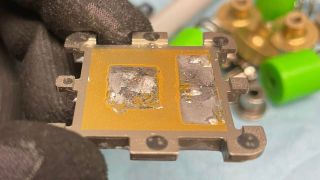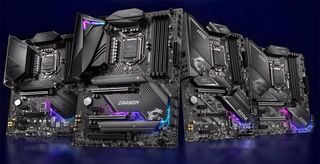Somebody's already pulled apart one of AMD's next-gen Zen 4 processors
We meant take a lid off the upcoming processors not delid the thing!

AMD is yet to take the lid off its Zen 4 processors—the red team's next-gen Ryzen 7000-series desktop CPUs aren't expected until later in the year. Yet it's rare these things stay under wraps for long leading up to launch, and just like that here's what appears to be a Zen 4 processor without any lid whatsoever.
An unnamed overclocker has somehow managed to get their hands on one of AMD's upcoming desktop processors ahead of launch and carried out the potentially risky procedure of delidding the chip. That's a process that involves removing the heat spreader (IHS) from the top of a processor's silicon; usually done for the purposes of replacing the heat spreader with a copper number or replacing the thermal interface material for better cooling.
Delidding is an especially risky procedure now that both AMD and Intel tend to solder their silicon to the underside of the IHS for improved heat transfer. You can see evidence of that solder in the image below, scooped by TechPowerUp of the IHS after it's been removed.
The exact source of the image has not been noted in an attempt to keep the overclocker from ending up in AMD's bad books.
This is a newly-designed IHS that will be introduced with Zen 4 processors and the AM5 platform, meaning this is our first look at its construction beyond renders provided by AMD. The tell-tale sign this is a Zen 4 IHS, or something that looks exactly like it, are the many feet around the edges. That's not something we've seen much of before, and AMD has already provided images that show this design.

You can also see that the Zen 4 IHS appears to be made out of a thick piece of metal, which could be a handy trait for keeping future generations of chips cool under load.
The thickness of the IHS could also be a tool by which to more evenly spread the heat generated by the chip out to its extremes for efficient cooling. Still, it's tough to say how much thicker it is than the existing AM4 IHS without a side-by-side comparison.
The biggest gaming news, reviews and hardware deals
Keep up to date with the most important stories and the best deals, as picked by the PC Gamer team.
Existing AM4 compatible coolers should largely work with the AM5 socket. That means for all the changes in the thickness of various parts, the socket design, etc., there are at least some key similarities in their construction. That said, AMD has shifted to an LGA chip with AM5, meaning the pins are no longer on the CPU itself but within the motherboard socket. That makes for a rather different-looking socket on the next-gen motherboards already announced.

Best gaming motherboard: the best boards around
Best AMD motherboard: your new Ryzen's new home
Judging by the three solder points on the AM5 IHS, I'd guess we're looking at a Ryzen 9 processor. The larger of the solder footprints seen on the IHS will be the cIOD, or the Zen 4 equivalent, and that manages all the I/O. The other two outlines will each contain a CCD chiplet, which will likely feature eight cores each. Not all those cores may be working, so this might be a 10-core or 12-core chip, but it also could be a 16-core processor.
It could also be a dud or an engineering sample of some sort. Engineering samples of AMD's chips are occasionally listed on eBay in the months preceding launch for a premium price, a common occurrence when AMD starts sampling chips out to OEMs and manufacturers that need to test these chips for their own product designs.
The fact somebody out there has a Zen 4 chip in hand could be a sign that they are heading our way relatively soon. Though it won't be until the end of the summer at the very earliest. AMD says these chips will arrive in the fall, but perhaps we can be hopeful of an early fall release now.

Jacob earned his first byline writing for his own tech blog. From there, he graduated to professionally breaking things as hardware writer at PCGamesN, and would go on to run the team as hardware editor. He joined PC Gamer's top staff as senior hardware editor before becoming managing editor of the hardware team, and you'll now find him reporting on the latest developments in the technology and gaming industries and testing the newest PC components.
Most Popular






